

MyMusicTheory. Grade six music theory lessons and exercises on tonal harmony, figured bass and composition. ABRSM syllabus. Free! - My Music Theory. Tom Pankhurst's ChoraleGUIDE - Voice-leading rules (Double SLAP) Composers have always paid careful attention to way in which their melodic lines work with each other, as well as to the individual shapes of the lines themselves.

The way in which the voices lead from one note to the next is called voice-leading. The texture of chorales is very simple, with all four voices are moving together, so anything awkward stands out very obviously. Bach is therefore particularly careful with the voice-leading in chorales, although the same basic principles are followed in virtually all tonal music. Freebies - www.martiandances.com. Music Theory marking criteria: Grades 6-8. Access the marking criteria for Music Theory Grades 1-5 Each Music Theory paper carries a total of 100 marks, 66 are required to achieve a pass, 80 to receive a merit and 90 for a distinction.
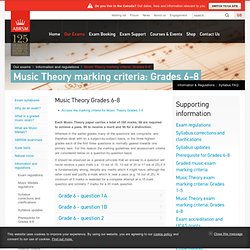
Whereas in the earlier grades many of the questions are composite, and therefore dealt with on a subject-by-subject basis, in the three highest grades each of the first three questions is normally geared towards one primary task. For this reason the marking guidelines and assessment criteria are considered below on a question-by-question basis. It should be observed as a general principle that an answer to a question will never receive a pass mark (i.e. 10 out of 15, 13 out of 20 or 17 out of 25) if it is fundamentally wrong, despite any merits which it might have; although the latter could well justify a mark which is near a pass (e.g. 16 out of 25).
5. Key Signatures - My Music Theory. Saturday, 14 August 2010 Grade 5 Online Course Hits: 85807 What are key signatures and why do they exist?
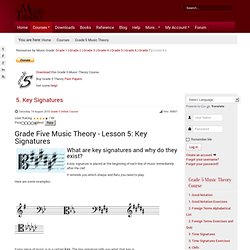
A key signature is placed at the beginning of each line of music immediately after the clef. It reminds you which sharps and flats you need to play. Here are some examples: Every piece of music is in a certain key. Every key signature represents two keys: one minor key and one major key. How do I write a key signature? You must write key signatures very carefully. Songs for interval recognition. Hearing the difference between 2/2 and 4/4, etc. Question: When listening, how can you tell the difference between 2/2 and 4/4? Or 3/4 and 6/8? - P.C. Answer: Often you can't tell the difference between 2/2 and 4/4, and sometimes it may appear that the composer made the choice for no other reason than simplicity in notation (writing fast eighth notes instead of sixteenths, perhaps).
David Berriman - Drama and Music. Last updated on 10/15/2013 Print this page1 Music graduate David Berriman has just released Aural Expert, an aural training application designed to help musicians develop their listening skills. The app covers intervals, scales, chords, pitches and tempo via a user-friendly and engaging interface. With variable difficulty settings, this app would benefit musicians of all levels. During his time at the University of Hull, David benefitted from similar software applications in the development of his own listening skills. Now a busy instrumental teacher, entrepreneur and programmer, he has developed this streamlined application for iPhone and iPad so that these listening skills can be practised at any opportunity, on the go. 1. Good Notation - My Music Theory.
Sunday, 08 August 2010 Grade 5 Online Course Hits: 72871 Western Staff Notation Notation is the system of symbols we use in order to write down music so that other people can play it.
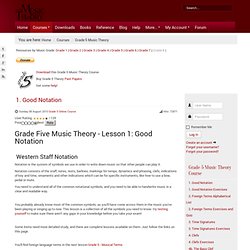
Notation consists of the staff, notes, rests, barlines, markings for tempo, dynamics and phrasing, clefs, indications of key and time, ornaments and other indications which can be for specific instruments, like how to use a bow, pedal or mute. You need to understand all of the common notational symbols, and you need to be able to handwrite music in a clear and readable way. You probably already know most of the common symbols, as you'll have come across them in the music you've been playing or singing up to now. Some items need more detailed study, and there are complete lessons available on them. You'll find foreign language terms in the next lesson Grade 5 - Musical Terms. Note Values. 9. SATB Writing for Voices - My Music Theory. Saturday, 14 August 2010 Grade 5 Online Course Hits: 40900 "SATB" is a quick way of referring to the four main voices that make up a choir, which are soprano, alto, tenor and bass.
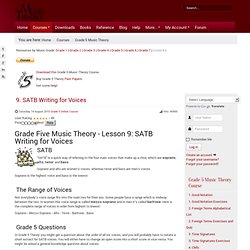
Soprano and alto are women’s voices, whereas tenor and bass are men’s voices. Soprano is the highest voice and bass is the lowest. The Range of Voices Not everybody’s voice range fits into the main two for their sex. WholeNote Guitar Lesson. Cadences. Gmajormusic 10: Cadences. Learning and Loving Music Theory. Kelvin, You actually caught a mistake on the roman numerals!
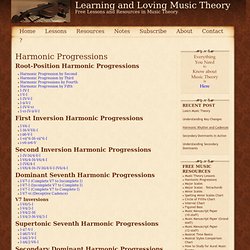
Thanks, I’ll have to fix that. The first and last chords of the progression are not 7th chords. Somehow I inadvertently typed “I7″ on the first chord of all the major keys. (Notice that I didn’t do that for the minor keys.) Rest (music) A rest is an interval of silence in a piece of music, marked by a symbol indicating the length of the pause.

Each rest symbol corresponds with a particular note value: The quarter (crotchet) rest may also be found as a form in older music.[1][2] The combination of rests used to mark a pause follows the same rules as for notes.[3] For more details see note value. Time is the measure of actual sound as well as of the opposite, its omission. MusicalMind.org Ear Training Online.